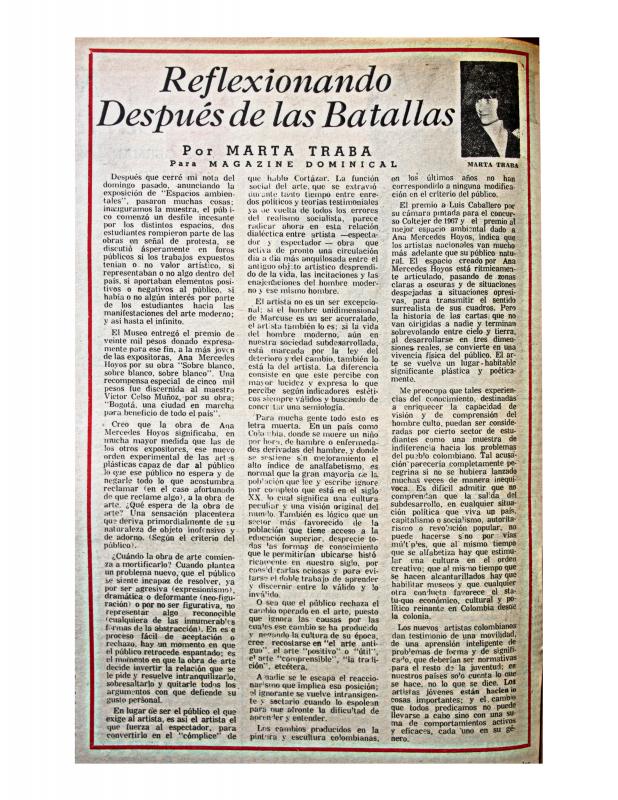The article “Generación Instalada” (1996) provides information about the V Bienal de Bogotá, one of the most important art events to take place in the nineties. The biennial, which featured the work of major Colombian artists of the time such as José Alejandro Restrepo (b. 1959), Óscar Muñoz (b. 1951), and María Teresa Hincapié (1954−2008), attempted to provide an overview of the artistic processes operative in Colombia. The first edition of the biennial was held in September 1988 at the impetus of the Museo de Arte Moderno and the Bogotá mayor’s office. The event, which commemorated the 450th anniversary of the founding of the Colombian capital, was initially intended to provide a venue for the work of young and emerging artists that advanced Colombian art. However, as curator Carmen María Jaramillo (b. 1958)—a member of the selection committee—explains in this article, the organizers of the fifth edition of the biennial realized that another salon, one specifically geared to young artists, had seen to providing a space for emerging work. Furthermore, there was greater demand for the work of artists under the age of thirty-five than for the work of more experienced artists. This state of affairs led to the decision to organize a show that would look back at the subsequent experiences of the artists who had participated in earlier editions of the biennial, thus reducing the age range. Despite that decision, six emerging artists—Lucas Ospina (b. 1971), Franklin Aguirre (b. 1969), Delcy Morelos (b. 1967), Leonel Galeano, Natalia Restrepo, and Adelaida López (b. 1966)—were invited to participate in the event.
The title of the article makes reference to two central issues addressed in the show: on the one hand, a generation firmly “installed” in the Colombian art scene and, on the other, the importance of the installation genre in production from those years. The writer of the article, María Margarita García (b. 1952), describes the show as “installation fever.” Her text depicts a transition underway in the nineties by which experimental practices involving a specific space—practices that first emerged in Colombia in 1963 with the exhibition Espacios Ambientales (1963) [see doc. no. 868555]—came to be called “installation.” This change was due to a re-conception of the socio-political importance of materials, postmodern readings of the construction of discourse, and the tendency to import international terminology and models to facilitate the later exportation of Colombian art. The work and the opinion of each of the artists participating in the biennial is described briefly in order to provide an overview that captures the biennial’s innately eclectic nature.
María Margarita García is a historian, journalist, and critic. She has published research such as the study Sin título, Luis Caballero 1966–1968 in conjunction with the Museo Nacional of Colombia. She worked for the art and culture section of La Prensa newspaper from 1985 to 1996. She is currently (2010) a critic and cultural commentator for Colombian magazine Diners.

